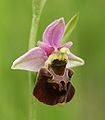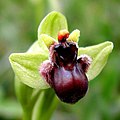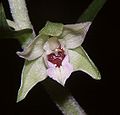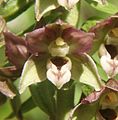Labellum
As Labellum (plural Labella, from the Latin word labellum "lip"), or lip , even honey lip is in botany the particularly striking trained, often, but not always, larger, median petal of the bloom covering (Perianth) of orchids referred and other species which is used to attract pollinators and as their landing platform.
The labellum plays a central role in the pollination process of the plants .
Labella occur in the following plant families, among others, but each emerged from different flower organs:
- Corsiaceae
- Flower cane family (Cannaceae)
- Ginger family (Zingiberaceae)
- Costaceae
- Stylidiaceae
- Orchids (orchidaceae)
In the flowers of the Corsiaceae family, the labellum is formed by one of the sepals , while in the orchids the third petal forms the lip.
(The controversial question of whether the flower circle of the orchid family is tepals or sepals and petals should remain undiscussed here. In the vast majority of orchid literature, the terminology sepals and petals is used and should also be used here in the descriptions priority mention of this plant family.)
In the family of orchids (Orchidaceae) the labellum of the flowers range showing the greatest wealth of shapes and colors and is next to the gynostemium belongs to the most striking part of the flower. In many cases the labellum bears a spur that contains nectar .
Often the top of the lip is covered with lamellae, ridges and calluses, which gives important distinguishing features of the species. Usually, however, the labellum is divided into two side lobes and a much larger middle lobe.
A typical behavior in the vast majority of orchids is the resupination of the underlying ovary by 180 ° at the end of the budding period . This process brings the lip, which was originally turned up, down in the inflorescence ; a process that apparently only occurs in orchids. An exception to this behavior is u. a. the native rebeard ( Epipogium aphyllum ), in which the labellum is placed on top.
Only in very few species is the labellum similar to the other two petals or it has receded.
Is the labellum small, take usually enlarged sepals (sepals) - rather than the petals (petals) - the task of luring pollinators spectacle apparatus as in some species of the genera Bulbophyllum , Disa and Lycaste .
Particularly noteworthy are the Labella of the species of the genus Ragwurzen ( Ophrys ), which imitate female insects in shape, color, size and scent (female mimicry ). When the male insects visit the flowers, the plants are pollinated (sexual deception flowers). This pollination mode occurs in a further ten genera of Australian orchids and occurs in the plant kingdom only in the orchid family.
Fly Ragwort
( Ophrys insectifera )Bumblebee Ragwort
( Ophrys holoserica )Drone Ragwurz
( Ophrys bombyliflora )King Ferdinand Ragwurz
( Ophrys regis ferdinandii )
The shoe-shaped labella of the four genera of the subfamily (Subfamilia) Cypripedioideae are built as a special pollination mechanism with sophisticated pollen transfer. If the insects want to leave the shoe into which they have slipped over the smooth lip, they can only do so via an exit at which they are inevitably provided with pollen .
Yellow lady's slipper
( Cypripedium calceolus )
Labella that have grown in a very complex way are sometimes used in
The labellum of the Stendelwurzen ( Epipactis ) is divided into front and rear lip, for example. The connection between the two parts of the lip is either connected to a movable member (for example, marsh stendrums ( Epipactis palustris )) or both parts are fused together and constricted at the transition. The nectar is in the hypochil.
Müller's Stendelwurz
( Epipactis muelleri )
Transition from
Epichil to HypochilShort-leaved Stendelwurz
( Epipactis distans )
Transition from
Epichil to HypochilNarrow-lipped stendellum
( Epipactis leptochila )
transition from
epichil to hypochil
literature
- Working group of local orchids (ed.): The orchids of Germany. Uhlstädt-Kirchhasel 2005, ISBN 3-00-014853-1 .
- H. Bechtel, Ph. Cribb, E. Launert: Orchideenatlas. 3. Edition. Ulmer, Stuttgart 1993, ISBN 3-8001-6199-0 .
- Robert L. Dressler: The orchids. Bechtermünz, Augsburg 1997, ISBN 3-86047-413-8 .
- G. Fast (Ed.): Orchide culture. Eugen Ulmer, Stuttgart 1995, ISBN 3-8001-6451-5 .
- R. Schlechter: The orchids. 4 vol. & Reg. Revised K. Senghas, 3rd edition. Blackwell-Wiss.-Verlag, Berlin / Vienna 2003, ISBN 3-8263-3410-8 .
Individual evidence
- ↑ Ernst Haeckel : General Morphology of Organisms. 1st volume. Georg Reimer, Berlin 1866, De Gruyter, 1988, ISBN 3-11-010185-8 (reprint), p. 506.















